#key performance metrics
Explore tagged Tumblr posts
Text
1 note
·
View note
Text
#key performance metrics#website performance metrics#performance metrics for employees#business performance metrics#project performance metrics#performance metrics and kpis#performance metrics analysis#performance metrics and reporting#performance metrics and evaluation#performance metrics and monitoring#api performance metrics#ai performance metrics#performance metrics best practices#performance metrics benchmarking#benefits of performance metrics#performance metrics calculation#performance metrics experience#performance metrics evaluation#employee performance metrics
0 notes
Note
How do preorder numbers affect your side of production? I’ve seen people saying that high preordering numbers lead to less time/budget to make the next game, because higher ups see it as proof that a studio/series can ride on name recognition instead of quality; is that true to your experience? In general, for a given game you worked on, would you prefer that people preordered or waited to day 1 purchase? Or does it not make a meaningful difference either way? Thanks!
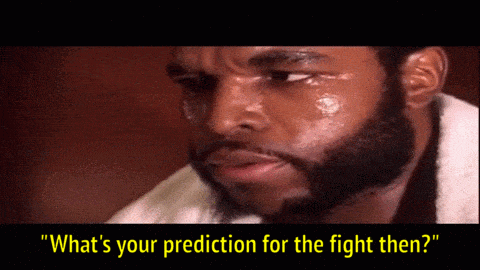
Up until around 2014, preorder numbers were strongly correlated with financial success. They were used as the main metric for determining an upcoming game's chance of hitting its goals. Unfortunately, this caused a common feedback cycle problem with key performance indicators - the more you optimize for the metric itself, the less that metric continues to correlate to what you actually want to know. Publishers and retailers pushed various tactics to pressure customers to preorder, which did result in more preorders. However, the artificially-juiced preorder numbers didn't correlate as strongly with the success of the games. As lifestyle games grew into the biggest chunk of the market, preorder importance fell even more because it was the lifestyle game populations that were most strongly correlated with financial success.
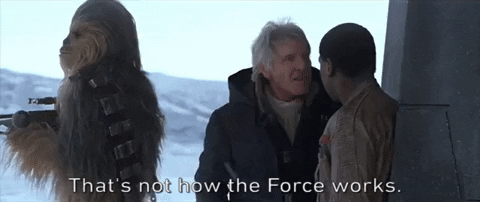
The quality element you mention has nothing to do with preorders. Most games have two to four years of total development time before they ship. Preorders for those games often aren't available until a few months before the release date. By the time the preorders numbers actually come in, we're nearly finished with the development process. The timing doesn't line up at all, there is no way we can cheap out on quality in the last few months of development when the majority of that work is already complete.

As for whether I think players should preorder... I'll tell you what I do personally when it comes to purchasing games. I don't care much for preorder bonuses in general - they are almost always very small and won't affect the overall gameplay in any significant way. Preorder bonuses are generally limited to cosmetics at best, and the gameplay itself matters much more to me than having a particular outfit or weapon skin. There are some games I will preorder because I really like the game or franchise and I am concerned that the publisher has limited print runs of that game (Atlus, for example, is famous for having small print runs). Aside from that, I usually wait to see how the game does at launch before buying in. I don't feel much pressure to get in on day 1. Waiting a week or two won't kill me, and I've got plenty of other games to play and things to do in the meantime.
[Join us on Discord] and/or [Support us on Patreon]
Got a burning question you want answered?
Short questions: Ask a Game Dev on Twitter
Long questions: Ask a Game Dev on Tumblr
Frequent Questions: The FAQ
30 notes
·
View notes
Text
Mastering KPIs: From Basics to Advanced Metrics
KPIs, or Key Performance Indicators, are everywhere in business, but they’re often misunderstood or misused. Having spent years working with teams across different industries, I’ve seen how the right KPIs can drive success, while the wrong ones can create confusion or, worse, false confidence. So, what exactly are KPIs, and how do you make sure you’re focusing on the ones that actually…
#actionable metrics#business metrics#business performance#Business Strategy#data-driven decisions#Key Performance Indicators#KPI tree#KPIs#measuring success#North Star Metric#Organizational Development#primary metrics#secondary metrics#team alignment
0 notes
Text
https://www.bloglovin.com/@vastedge/kpi-dashboards-a-visual-guide-to-business
Unlock the power of KPI dashboards with this visual guide. This blog post provides insights into how KPI dashboards can enhance business performance by offering clear, actionable data visualizations. Learn how to design and utilize these dashboards to monitor key metrics, make informed decisions, and drive strategic growth.
#KPI Dashboards#Business Performance#Data Visualization#Key Metrics#Dashboard Design#Performance Tracking#Business Intelligence#Strategic Growth#Data Analytics#Visual Analytics
0 notes
Text
Fray
I hope that it still rings in your heart. I hope that I loved you the way you wanted me to,and I made your mornings a worthwhile moment,and that I have brought the sunshine by your bedside even when days are painted with gloom and ashy clouds, and I hope that when you exited your dream that you found waking up with me a fair trade. If my silence hurt you when we argued, know that I wasn’t…

View On WordPress
#Arguments#Colors#Dreams#Eden#Erwinism#Fire#Five Star#FYP#Gloom#Goodbye#Heard#Heart#Inspiration#Key Performance#Learning#Life#Love#Love Language#Metrics#Moonlight#Mornings#Motivation#Poem#Poetry#Progress#Serenity#Silence#soul#Storm#Sunshine
0 notes
Text
Mastering E-Commerce: Navigating Goals for Optimal Online Success

In the vast expanse of e-commerce, success is not merely about existence; it's about standing out, thriving, and achieving sustainable growth. Without a meticulously crafted plan, your digital presence risks being lost amidst the ever-expanding digital crowd. Enter the pivotal concept: setting clear and ambitious goals. In this comprehensive guide, we delve into the essential goals of e-commerce, offering a roadmap to not just meet but exceed them, ensuring your venture's prosperity in the dynamic digital landscape.
#e-commerce objectives#goals of online business#e-commerce success factors#achieving e-commerce goals#strategic goals in e-commerce#e-commerce performance metrics#key performance indicators for online sales#maximizing e-commerce profitability#e-commerce growth strategies#measuring e-commerce success
0 notes
Text
5 KPIs Powering AI Startups

In the fast-paced world of artificial intelligence (AI), startups constantly seek innovative ways to carve out their niche, differentiate their products, and capture the attention of a discerning customer base. Within this highly competitive landscape, the ability to launch and effectively measure the impact of marketing campaigns is no longer a luxury—it's a necessity. This is where the critical role of metrics, including key performance indicators (KPIs), comes into play, serving as the compass that guides AI startups through the complex and often tumultuous waters of market penetration and customer acquisition.
Importance of Metrics in Marketing
Measuring marketing performance is essential for AI startups, which often face challenges like limited budgets and the need to explain complex technologies. Metrics provide tangible insights beyond surface-level data, enabling startups to gauge the health and potential of their growth trajectory. By analyzing the right metrics, startups can optimize their strategies, allocate resources efficiently, and pivot quickly in response to market feedback.
Understanding Marketing Metrics
In marketing analytics, there's a distinction between vanity metrics and actionable metrics. Vanity metrics, such as social media followers or page views, may look impressive but often lack meaningful insights. On the other hand, actionable metrics, like conversion rates and customer acquisition costs (CAC), are directly tied to business objectives and provide valuable insights into customer behavior and marketing effectiveness.
Setting Clear Objectives
Establishing clear, measurable objectives is foundational to any successful marketing strategy. For AI startups, objectives should be specific, measurable, achievable, relevant, and time-bound (SMART). By setting precise goals aligned with the startup's overarching business objectives, startups can tailor their marketing strategies effectively and track progress accurately.
Key Performance Indicators (KPIs) for AI Startups
In the high-stakes world of AI startups, where innovation meets market realities, understanding and leveraging key performance indicators (KPIs) is essential. These metrics not only lead the path to growth but also ensure that every step taken is informed, intentional, and aligned with the startup's overarching objectives. Below, we will discuss critical KPIs for AI startups, exploring their definitions, calculations, and strategic importance, alongside insights on leveraging analytics tools for continuous improvement.
Customer Acquisition Cost (CAC): CAC represents the average cost of acquiring a new customer and is crucial for assessing the efficiency and sustainability of growth strategies. While industry benchmarks can provide insights, startups should focus on optimizing their CAC to ensure cost-effective customer acquisition.
Customer Lifetime Value (CLTV): CLTV forecasts the total value derived from a customer throughout their relationship with the business. Understanding CLTV helps startups determine how much to invest in acquiring customers and identify valuable customer segments for targeted marketing efforts.
Conversion Rates: Conversion rates measure the percentage of potential customers who take desired actions, such as purchasing or signing up for a trial. Tracking conversion rates at each stage of the marketing funnel helps identify bottlenecks and optimize the customer journey for improved conversion.
Engagement Metrics: Metrics like time on site, pages per session, and repeat usage are vital indicators of product value and customer satisfaction. High engagement levels often correlate with higher retention rates and customer lifetime value, making them essential for assessing product-market fit and user experience.
Return on Investment (ROI): ROI measures the efficiency and effectiveness of marketing expenditures by comparing sales growth to marketing investment. Understanding ROI enables startups to make informed decisions about budget allocation and optimize marketing strategies for maximum impact.
Case Studies: Success Stories
Examining the success stories of AI startups provides valuable insights into the practical application of metrics-driven marketing strategies. For example, AlphaAI reduced CAC by implementing targeted content marketing, while BetaAnalytics increased CLTV through personalized user experiences. GammaVision doubled marketing ROI through rigorous experimentation and A/B testing.
Conclusion: In conclusion, a metrics-driven approach is essential for AI startups to navigate the complexities of the marketing landscape successfully. By focusing on key performance indicators like CAC, CLTV, conversion rates, engagement metrics, and ROI, startups can optimize their marketing strategies, allocate resources effectively, and achieve sustainable growth. Continuous measurement, analysis, and optimization are critical for success in the dynamic and competitive AI market.
#AI Startups#Key Performance Indicators#Data-driven marketing#Customer acquisition cost#Customer lifetime value#Conversion rates#Engagement metrics#Marketing ROI#Analytics tools#Data-driven culture
0 notes
Text
A Comprehensive Journey into Objectives and Key Results (OKRs)

In the dynamic landscape of today's business world, organizations are constantly seeking effective frameworks to align their teams, set ambitious goals, and drive performance. Objectives and Key Results (OKRs) have emerged as a powerful methodology to help businesses articulate and achieve their objectives. In this comprehensive exploration, we delve into the essence of OKRs, shedding light on their significance and how BullseyeEngagement's OKR solutions elevate goal-setting and performance tracking.
Understanding Objectives and Key Results (OKRs)
Objectives and Key Results (OKRs) is a goal-setting framework that originated in Intel and was later popularised by companies like Google. At its core, OKRs provide a simple yet powerful approach to setting and achieving goals. Objectives represent the ambitious and qualitative outcomes an organization aims to accomplish, while Key Results are specific, measurable, and time-bound indicators that signify progress towards the Objectives.
The OKR framework encourages transparency, collaboration, and alignment across an organization, breaking down silos and fostering a shared sense of purpose. It's a flexible system that allows companies to adapt quickly to changing market conditions while keeping the entire organization focused on common goals.
The OKR Framework in Action
To illustrate the practical application of Objectives and Key Results, consider a technology company with an Objective to "Improve Customer Satisfaction." The corresponding Key Results could include metrics such as "Increase Net Promoter Score (NPS) by 15 points," "Decrease average customer response time by 20%," and "Achieve a 90% customer issue resolution rate within 24 hours."
By defining clear and measurable Key Results aligned with the overarching Objective, teams can stay focused on what truly matters, ensuring that their efforts contribute directly to the organization's success.
BullseyeEngagement's Role in OKR Solutions
BullseyeEngagement stands out as a leading provider of OKR solutions, offering a comprehensive platform that streamlines the entire OKR process. Their suite of tools empowers organizations to set, track, and achieve their goals efficiently.
Alignment and Collaboration
BullseyeEngagement's OKR solutions facilitate seamless alignment across departments and teams. By providing a centralized platform, BullseyeEngagement ensures that every employee understands how their individual objectives contribute to the broader organizational goals, fostering a culture of collaboration and shared accountability.
Real-Time Tracking and Analytics
With BullseyeEngagement's OKR solutions, organizations can move beyond traditional annual performance reviews. The platform enables real-time tracking and analytics, allowing teams to monitor Key Results, identify bottlenecks, and make data-driven adjustments to stay on course. This dynamic approach enhances adaptability and responsiveness to evolving market conditions.
Feedback and Recognition
Effective goal management goes beyond setting objectives; it involves continuous feedback and recognition. BullseyeEngagement's platform integrates features for providing constructive feedback and acknowledging achievements. This ensures that employees feel motivated and valued, driving sustained high performance.
Customization for Unique Organizational Needs
BullseyeEngagement understands that each organization is unique. Their OKR solutions offer customization options, allowing businesses to tailor the platform to their specific needs and industry nuances. This flexibility ensures that the OKR framework seamlessly integrates with existing processes and workflows.
Conclusion
Objectives and Key Results (OKRs) serve as a compass for organizations navigating the complexities of the modern business landscape. By adopting a results-oriented mindset and leveraging BullseyeEngagement's OKR solutions, businesses can unlock their full potential, align their teams, and drive sustained success.
As the business world continues to evolve, the synergy between a robust goal-setting framework like OKRs and innovative solutions from BullseyeEngagement paves the way for organizations to thrive in an era defined by agility, collaboration, and measurable results.
#Objectives and Key Results#OKR Framework#Goal Setting#Performance Metrics#Strategic Planning#Business Objectives
0 notes
Note
I think you suck at your job, are there any openings to become YOUR coach
I could hardly believe the words that were coming out of his mouth. Sitting in front of me - at the very desk that I called my own - the smug face of the suited young man would hardly look at me while he tapped away at my keyboard, looking through the gym’s accounts and printing off content for his report.


“Who even are you? There must be some mistake here...” I tried to protest as I threw my own kit bag down on the chair.
“I’m from corporate. You would have known if you showed up on time - but instead, your front desk key has recorded that you usually arrive around midday.” He was right, but I didn’t want to admit it. “Metrics and reports don’t lie.”
I slumped into the ‘interview chair’ while he proceeded to give a tedious and gruelling reminder of all company policy - most of which was never adhered to in the first place.
“... lastly, it is quite clear that you’ve slipped from our updated franchisee guidelines which means that the only logical resolution will be a total restart.” I heard as I zoned back in.
“Excuse me?” Before I even had a chance to realize what was being said, the auditor turned the monitor around to face me. The document displayed had the company logo, followed by a strange pulsating pattern on the background that I couldn’t quite place. The smug smile once again hidden behind the screen, he continued hitting the presentation with the space bar as my eyes locked on the content... it all looked.. so familiar, almost like I remember seeing the document before... a long, long time ago...
…
SLIDE 5: PROFILE
Our records show that the current generation is 285% more responsive to Coaches with the following attributes:
- Fit, Healthy and a visible reflection of the Gym culture
- Motivated, forthcoming and persuasive
- Closer in age to the average attendee (18 - 30 demographic)
...
SLIDE 16: FUNCTION
You will showcase all that the facility can offer. You will be personally responsible for inductions, checking the progress and encouraging new recruits to achieve their goals to the best of their abilities - and also through the company’s resources.
...
SLIDE 105: UNIFORM
Good Coaches need to set an example. You need to showcase optimum routine and form. Never forget that you are their motivator - wear it with pride.


“I will set an example… I will display optimum performance…. will wear my uniform with pride…”
Something tells me that the gym won’t be visited by corporate in a long while.
—
If you enjoyed this tf, you can send me a tip on Ko-Fi and for more tf locker room posts and to request your own, follow @coachs-locker-room
Corporate representative: @suiteddaily / Post TF: Rodrigo Rodríguez
138 notes
·
View notes
Note
metric fan.... what are your thoughts on art of doubt ? i'm trying to get into metric and that's the one album that's clicking with me big time... it's so good
i have strongly mixed feelings about art of doubt, and broadly about this newer era the band is in
i hated pagans in vegas. that album was a major slump. i thought they were going the way of bloc party or lcd soundsystem or any number of weirdo indie rock bands from the 00's, where they'd keep on truckin but never reach their glorious highs again...
well, it didn't turn out that way. art of doubt is a triumph, a return to form, and proof they can still write a great rock album. emily's voice is in top form. i've always loved how delicate and sincere she sounds on mic, and middle age has only made those qualities stronger. listen to her gliding across that slippery groove in "anticipate," fluttering breathlessly over the chorus of "underline the black," or balancing between warmth and sarcasm on "seven rules." performances like these make a metric album worth it
i think art of doubt contains some of the best metric songs EVER. "now or never now" is genuinely a top 10 indie rock song imo. when it's on, i never want it to end. "dressed to suppress" is a really knockout track, the kind no one else seems to make anymore. and the last 3 songs are gorgeous. they're naked and unpretentious in a way that just melts my heart
and can i just say the production is killer. metric albums are usually super crisp and detailed, but this one blows em all out of the water. every drum hit BANGS. the guitars on this whole album sound phenomenal
all that said, i think the album has problems. emily pushes her voice outside her comfort zone a few times and... sometimes that works, like on those high notes in "no lights on the horizon." sometimes it DOES NOT WORK, like when she tries to scream some lines on the title track. her voice refuses to get loud and she just yelps awkwardly. the production tries to help her out by adding some distortion, but that only makes it worse. moments like this draw attention to how one-dimensional this album is outside of some key moments.
but here's my real beef with art of doubt, as well as formentera 1 and 2. these songs have a terrible case of "bad verse, great chorus" disease. "die happy," "holding out," and "dark saturday" are the worst offenders here. the choruses sound like they're totally disconnected from the verses around them. the transitions are janky and abrupt, and when the chorus ends my only thought is "damn, i have to slog thru 30 more seconds of sludge before i can get back to the song i was enjoying." so many of the deep cuts have this problem, and it makes the whole album feel choppy and stilted
overall, i like the record. i like it a lot. but on repeated listens, i end up skipping more and more songs until i'm left with the handful i truly love. not my fav metric album, but i'll admit it's grown on me since it dropped
if you like art of doubt, do yourself a huge favor and listen to synthetica. the whole album, front to back. it's one of the greatest alt rock albums ever written. when you're done, listen to fantasies. it's their most popular, and it's equally great.
somewhere in there, find some time for this playlist i just made: metric essential deep cuts. emily doesn't get enough credit as a master lyricist and songwriter. together, the haines-shaw songwriting duo are truly special, the kind of thing you're lucky to get once in a generation. i hope this playlist makes a case for that <3
#metric#music writing tag#I WILL TAKE ANY OPPORTUNITY TO RAMBLE ABOUT MUSIC#ESPECIALLY THIS BAND I LOVE <3 <3 <3
76 notes
·
View notes
Text
#kpi metrics#kpi stands for#kpi vs okr#kpi dashboard#kpi solutions#smart kpi#kpi analysis#kpi and okr#kpi benchmarks#key performance indicators#key performance indicators (kpis)#key performance indicators for employees#key performance indicators vs metrics#key performance indicators for project management#kpi key performance indicator#key performance indicator and dashboard#key performance indicators advantages and disadvantages#key performance indicators articles#key performance indicators and critical success factors#key performance indicators benefits#blog on key performance indicator#key performance indicator calculator#criteria for key performance indicator#difference between objective and key performance indicator
0 notes
Note
I'm curious about you referring to white voice actors playing non-white characters as "skinsuit representation". Would you feel the same way about a white character voiced by a non-white voice actor? Is it important only if the character has specific cultural ties?
I personally think that most of the time the most important aspect of voice casting is how well they play the character, and everything else is secondary.
The key flaw to this kind of logic is that we simply don't live in a meritocracy. The industry doesn't hire solely based on skill, systemic biases come into play. I don't have a problem with like, Phil LaMarr voicing white Aquaman in Young Justice because if POC voice actors voiced only POC characters, they wouldn't get a lot of jobs because of how white the media and the industry is.
So when a white actor voices a character of color, to me, that's taking away one of the few job opportunities designed for actors of color. There's hiring based on skill and then there's also labor justice. How can new voice actors of color gain experience in voice acting professionally when there's so few jobs for them to get to hone their craft? It's about how the talent behind animated projects should reflect the diversity they're presenting on screen. You can't claim to be a "diverse" show when that diversity is only on screen. That's performative.
And to your point "the most important aspect of voice acting is how well they play the character",,,how does a white voice actor do a better job voicing a non-white character than a more authentically cast voice actor? It's the same logic behind when you say "is it important only if the character has specific cultural ties" How would we arbitrarily measure how culturally connected a character is? And is that a fair metric for deciding if that animated character is worthy of being casted authentically? Regardless of where a character falls in this chart I made, I think they all should be casted authentically.
I hope that in the inevitable animated musical biopic about my life atrocities and crimes, the movie doesn't use the fact that I'm not particularly culturally connected to justify casting Scarlett Johansson as me. Or Awkwafina.
#askjesncin#this is technically the same logic behind “would u be mad if we racebent poc characters into white ppl” like yea duh#cuz there's so few of us already in media and you're just taking it away and representing more of the majority#think less in terms of “skill is what matters” and okay but what are the realities of the industry tho#imagine having characters of color in your show and not a single voice actor of color is hired. ur “diversity” failed to uplift real ppl
64 notes
·
View notes
Text
Why even write code anymore? Just have automated permutations until it compiles, passes all the tests, and then do an A/B test? If key performance metrics are up, great! Include it and go to step 1!
58 notes
·
View notes
Note
out of curiosity, if Max doesn’t release its metrics, then what metrics are you actually using to make these statements about the show’s popularity? what does “it’s currently in the 99.7th percentile of the comedy genre, meaning it’s in higher demand than 99.7% of all comedy series in the u.s.” even mean? How are you measuring what’s “in demand” - by who? Where? It’s bold to claim that this show was wildly popular (despite the fact that I never hear about it outside of tumblr, tho that’s a personal anecdote) but cancelled just for being queer, so I would be really interested to know where you’re getting all these numbers from. Thanks!
hey anon! first of all i am so sorry for the delayed response. i started typing something up and then i got distracted with something else and totally forgot about this in my drafts.
sure, i have no problem citing sources. i probably should’ve linked some in my original post, that’s absolutely fair.
this ended up way longer than i planned so bear with me, but a quick overview of what i’ll be going over:
1) what are the stats/where did they come from?
2) how is the show so popular?
3) was it really cancelled for being queer?
(also just a disclaimer that this will contain spoilers for the show)
1) first, the numbers
you’re right that hbo doesn’t release metrics to the public. in fact, ceo casey bloys tried to justify the cancellation to the hollywood reporter by saying “the numbers weren’t there,” despite refusing to say what exactly those numbers were or where they came from.
however, there are websites dedicated to researching/analyzing the data of different media. one of those is parrot analytics, who focus on industry insights like audience demand, competitive analysis, and content valuations. they’re trusted as a reliable source by forbes, the new york times, reuters, the wall street journal, and more.
this is what we can learn from them about our flag means death from a basic google search (note that all of this data is relevant to the last 30 days as of january 26 2024):

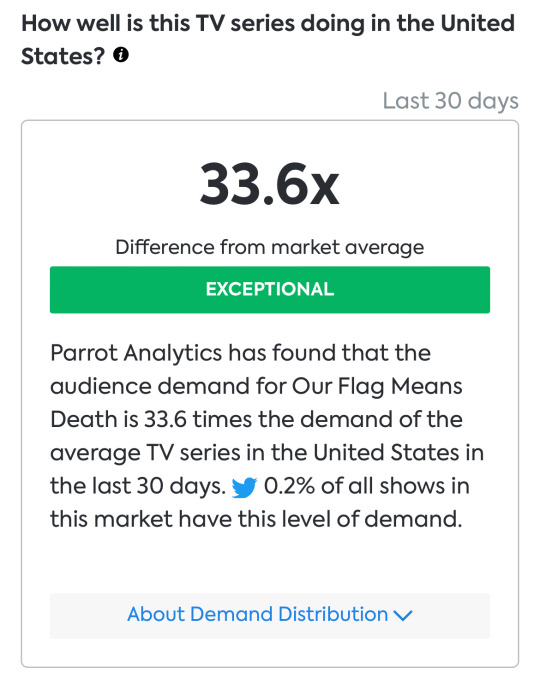
audience demand for our flag means death is now 33.6x greater than the average tv series in the united states. as explained in the “about demand distribution” section, this means it’s one of only 0.2% of all u.s. shows to fall in the “exceptional” performance range compared to the “average” demand benchmark of 64.1%.

the change in demand for ofmd in the u.s. has increased by 7.5% compared to the average tv series.
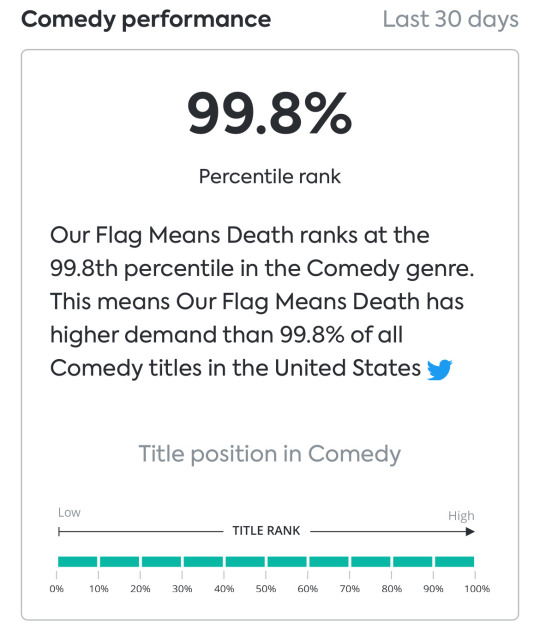
ofmd now actually ranks at the 99.8th percentile in the comedy genre in the u.s. i’m not a math person, but in basic terms, this is like a scale of measuring and comparing performances to create an average score. essentially, ofmd is performing at the very top of all comedy series in the u.s.
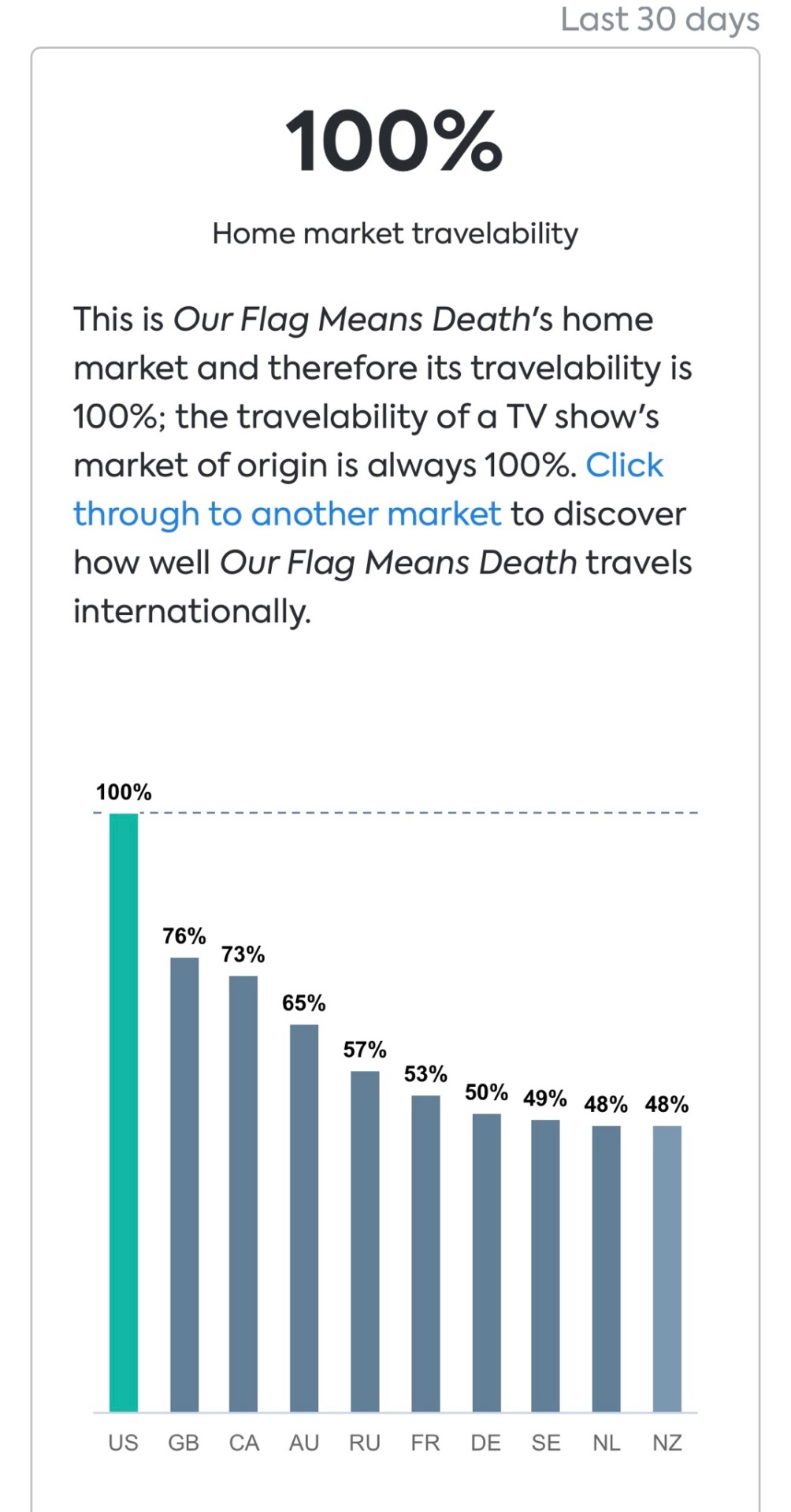
ofmd has 100% home market travelability. as it says above, the market of origin is always 100%, so in fairness i included the graph of international markets for comparison. some of these aren't super high, however (as explained by parrot analytics themselves) one of the key issues with the international market is accessibility to content, which has been an ongoing struggle for international fans. many people (i guess fittingly) have resorted to pirating ofmd because they don’t have access to max or affiliate streaming services in their country.
there are more stats i could have and wanted to go more in-depth into but it would make this even longer than it already is, so i’ll just leave some links you can check out if you’re interested and move on:
• comparison of ofmd's success to shows like ted lasso, euphoria, and peacemaker
• ofmd's placement as #1 most in-demand breakout series in the u.s. for 8 weeks
• ofmd's impressive 94% critics score and 95% audience score on rotten tomatoes
• how ofmd evolved from sleeper hit to a flagship series at max
• a list of ofmd's past and present award nominations/wins
• praise and recognition from news/entertainment sites: the atlantic (2022); the new york times (2023); tv guide (2023); vulture (2023); forbes (2023); the los angeles times (2022); vanity fair (2023)
2) so why haven’t you (or others) really heard of the show outside of tumblr despite all this success? likely because max did a terrible job marketing it.
ofmd first aired on hbo max (pre-merger before it was “max”) in march 2022. the entire season aired over one month, every thursday at 12am pst. season 2 followed a similar release schedule in october 2023.
season 1’s marketing was almost non-existent, pretty much relying on taika waititi’s name being attached. there was one teaser and one full-length trailer, as well as a few clips on youtube of taika and rhys darby answering pirate-themed trivia, all painting the show as a “silly pirate workplace/buddy comedy.” but hbo max didn’t put any real effort in because they didn’t care. david zaslav and the other higher-ups had no faith in the show and expected it to fail.
most people weren’t aware it was actually a romance due to the poor marketing, and although there were many romantically charged scenes between them, many were still wary to believe it wasn’t queerbaiting until ed & stede confessed their feelings and kissed.
showrunner david jenkins has said in interviews that he had no idea how deeply queerbaiting had hurt audiences and impacted their ability to trust what’s on screen without feeling like they’re being ridiculed, despite the fact that he was calling it a love story the whole time. it wasn’t until people realized they weren’t being queerbaited and that it was a funny, sincere show with a compelling plot that word-of-mouth began to spread. by the time the season 1 finale aired, there was a decent-sized fandom that continued to grow as it received more praise.
it was a fight to even get the show renewed for season 2, and david jenkins and the cast have majorly credited that renewal to the unexpected and massive fan response to the show, which basically forced hbo’s hand.
max didn’t bother trying to properly promote the series until season 2, when they begrudgingly accepted that it was one of their most profitable and successful shows. ofmd had huge billboards in times square, downtown los angeles, and on the side of hbo headquarters. they started accurately marketing the show as not just a workplace comedy at sea, but a heartfelt romcom. max began selling long-demanded merch (which became best sellers) and spent money on an FYC campaign.
i will emphasize, whether they liked it or not, they knew ofmd was their new moneymaker (especially with the recent end of succession, which was obviously a cash cow for hbo).
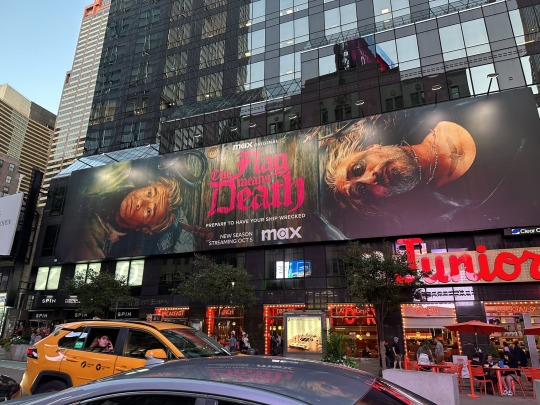
photo credit: @/bookishtheo
3) now if it was that successful, was it really cancelled just for being queer?
i mean, i can’t say that definitively. no one can. there are several potential factors at play that we may never know, and there have been a lot of rumours and speculation (many of which i don’t feel comfortable discussing in case they aren’t true) since the cancellation.
but do i believe the fact that it’s a queer romcom was one of those factors, especially since max has a history of cancelling and scrapping its most diverse projects? absolutely.
first and foremost, i can’t stress enough that this isn’t just a show with a few characters thrown in for token representation. ofmd is built on a diverse, intersectional cast and narratives, including:
• lgbtq+ representation: 5 main couples are explicitly queer (including mlm, wlw, nblm, and nblw relationships). multiple characters are implied to be poly, and there’s a polycule forming in season 2 that was hinted to be developed more in season 3. beyond relationships, it’s confirmed that (similarly to the way wwdits depicts all vampires as being pansexual) all of the pirates are somewhere on the queer spectrum.
• bipoc representation: the majority of the main cast are people of colour. this includes david fane, joel fry, leslie jones, samson kayo, vico ortiz, anapela polataivao, madeleine sami, samba schutte, ruibo qian, and taika waititi, as well as many guest actors (like rachel house, simone kessell, and maaka pohatu) and extras.
• disability representation: multiple characters have physical disabilities, most notably amputated/prosthetic limbs and visual impairment. a lot (actually most) of the characters also deal with mental health issues, particularly coping with severe trauma and suicidal ideation/behaviour.
• the show has been praised for addressing difficult and serious themes like toxic masculinity, colonialism, and self-discovery, all while still managing to be a witty comedy and not come across as “preachy.”
• the diversity also extends off-screen, with a team of directors, writers, and additional crew comprised of numerous bipoc, women, queer people, and trans/non-binary people.
my point isn’t just the quantity of representation, but the quality. they take great care and respect into every marginalized group depicted on-screen. the actors would often be consulted about their characters’ costumes, hair, tattoos, and the kind of language they use. it’s not a world where discrimination magically doesn’t exist, they just have zero tolerance for it. if a character does something homophobic or racist, you can guarantee they’ll quickly (and often violently) be punished.
so okay, sure, it’s got great representation. what does that have to do max cancelling it?
because they’ve been interfering with production from the start.
i already mentioned the marketing issues so i won’t get into that. it was also revealed in interviews with david jenkins after season 2 that hbo cut their budget by 40%, which is why they had to do everything they could to save money. this included letting go of some of the original cast (and even still having episodes where some of them don’t appear at all) and moving the entire production to AoNZ. the budget cuts also meant two less episodes, so they had to rush to fit an entire season’s worth of plot into eight half-hour long episodes.
but one of the biggest frustrations is hbo’s (alleged) censorship of the show. samba schutte revealed that the entire plot of episode 2x06 was completely different in the original script. before it was rewritten as “calypso’s birthday,” the episode took place during lucius & pete’s wedding and focused on the crew getting sick of the sexual tension between ed & stede and trying to get them to hook up (this aligned with lucius & pete getting engaged and ed & stede deciding to take things slow in the previous episode).
vico ortiz and writer jes tom have also commented that many scenes between jim, oluwande, and archie establishing them as a polycule were cut, including one of the three of them emerging from a bedroom in their underwear. jes has mentioned other elements of season 2 that had to be cut out or rewritten, like the implication of other poly dynamics between the crew and more sexually explicit scenarios and jokes.
considering that ofmd is an extremely sex-positive show that isn’t afraid to be raunchy or taboo, it’s clear that either higher-ups at hbo forced them to cut these things out or they had no choice but to cut them out due to tight budget/time restraints.
in addition to this, a recent article citing an “anonymous insider” has alleged that hbo was uncomfortable with and was unsure how to market the “shock violence” in the show (the same network that aired game of thrones), which david jenkins outright called out as being bullshit. ofmd is rated TV-MA and the posters and trailers all show the audience that it contains violent content. there is literally nothing more graphic in ofmd than any other pirate show — it’s probably a lot tamer than most of them, actually.
violence on the show is most frequently used in a comedic context, in the sense that it’s not meant to be seen as scary or taken seriously. the few instances of serious graphic imagery on the show are meant to invoke a mood shift, like ed’s transformation into the kraken or ned low’s murder. it should also be noted that some of the most graphic deaths are reserved for bigots, like ed snapping the neck of a colonizer who was ridiculing stede’s love letter.
it’s also most often used in a sexual context — not sexual violence, but violence as a sexual metaphor. more specifically the act of stabbing as a metaphor for penetration, as seen with both ed & stede and anne & mary. bearing all this in mind, it seems like the real issue here isn’t executives struggling to market explicit violence to a mainstream audience, but rather explicit gay content.
as much as we joke and affectionately call it the “gay pirate show,” ofmd has always been nothing more than an opportunity for rainbow capitalism for hbo (e.g. the fact that they waited three months to announce season 2 just so they could do it on the first day of pride month). like other cancelled queer media, ofmd was a way for hbo executives to show how “inclusive” and “accepting” they are when it was convenient (aka profitable) for them, but they never actually respected the show or us as a community.
it’s impossible to be certain of what the exact reasoning for cancellation was, especially when they won’t give us a clear answer themselves. and maybe it had nothing to do with ofmd being a queer romcom at all. maybe that’s all a horrible coincidence. but for hbo/max to axe a critically acclaimed and beautifully inclusive show that’s successful by every metric, with an extremely devoted fanbase, especially after casey bloys just had the nerve to ask “gay twitter” to hype up the gilded age? it doesn’t exactly put them in the best light regardless.
in summary, i’ll leave you with this editorial, which details how the campaign to save ofmd isn’t just about one show, but a fight to save the future of all queer art.
109 notes
·
View notes
Text

SEO for YouTube: How to Optimize Your Videos for Search
Meet Paul. Paul is a budding YouTuber with a passion for tech reviews and tutorials. He’s been creating content for a while, but his channel isn’t growing as quickly as he’d hoped. Paul’s videos are high-quality, informative, and engaging, yet they’re not reaching a wide audience. The key problem? His videos are not optimized for YouTube’s search algorithm. This is where SEO, or Search Engine Optimization, comes into play.
Understanding YouTube SEO
SEO for YouTube involves optimizing your videos so they rank higher in search results. Higher ranking videos get more views, which can lead to more subscribers and overall channel growth. Here’s how Paul can optimize his videos for YouTube search:
Keyword Research
Paul’s first step is to find the right keywords. Keywords are the terms and phrases that users type into the search bar when looking for videos. Paul uses tools like Google Trends, TubeBuddy, and VidIQ to identify popular keywords related to his content. For instance, if Paul’s video is about the latest iPhone review, he might discover that “iPhone 14 review,” “iPhone 14 unboxing,” and “iPhone 14 vs Samsung Galaxy S22” are popular search terms.
Optimizing Video Titles
Once Paul has his keywords, he needs to incorporate them into his video titles. A good title is clear, concise, and includes the main keyword. For example, instead of titling his video “My Thoughts on the New iPhone,” Paul titles it “iPhone 14 Review: In-Depth Look at Apple’s Latest Smartphone.” This title is more likely to match what users are searching for.
Creating Engaging Thumbnails
Thumbnails are the first thing viewers see. An eye-catching thumbnail can significantly increase click-through rates. Paul creates custom thumbnails that are visually appealing and relevant to the video content. He includes the video title or key phrases in the thumbnail to attract viewers’ attention.
Writing Detailed Descriptions
The video description is another crucial SEO element. Paul writes detailed descriptions for his videos, incorporating his main keyword and related terms naturally. He includes a brief summary of the video, timestamps for different sections, and links to his social media, website, and other relevant videos. This not only helps with SEO but also provides a better viewer experience.
Using Tags Effectively
Tags help YouTube understand the content of a video. Paul uses a mix of broad and specific tags, including his main keyword and variations of it. For his iPhone review video, he might use tags like “iPhone 14,” “iPhone review,” “Apple smartphone review,” and “tech reviews 2023.”
Engaging with Viewers
Engagement metrics like likes, comments, and watch time also influence search rankings. Paul makes an effort to engage with his audience by asking questions in his videos, responding to comments, and encouraging viewers to like and share his videos. The more engagement his videos get, the higher they are likely to rank.
Promoting Videos on Social Media
Paul doesn’t rely solely on YouTube’s search algorithm to drive traffic. He promotes his videos on social media platforms like Twitter, Facebook, and Instagram. By sharing his videos with a broader audience, he increases the chances of getting more views and engagement.
Analyzing and Adjusting
Finally, Paul regularly reviews his analytics to understand what’s working and what’s not. He looks at metrics like watch time, click-through rates, and viewer retention. Based on this data, Paul adjusts his SEO strategy and content approach to continually improve his channel’s performance.
Conclusion
Through consistent effort and strategic optimization, Paul starts to see his videos rank higher in YouTube search results. His channel grows steadily, attracting more viewers and subscribers. By following these SEO practices, Paul not only improves his search rankings but also enhances the overall quality and reach of his content.
For any YouTuber looking to grow their channel, understanding and implementing YouTube SEO is crucial. Just like Paul, you too can optimize your videos and achieve greater success on the platform.
33 notes
·
View notes